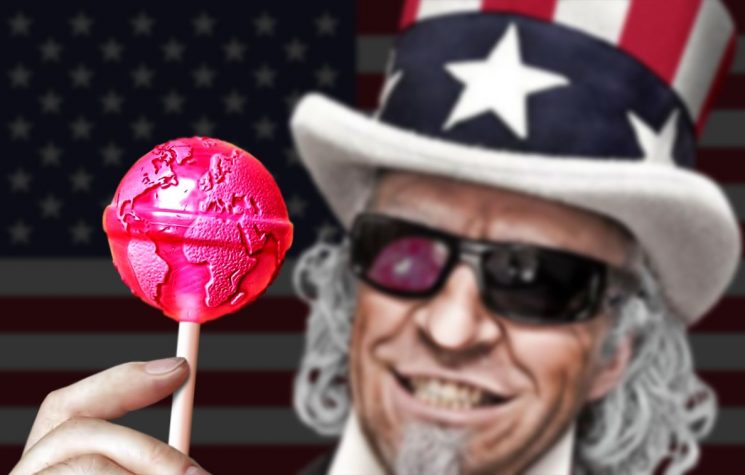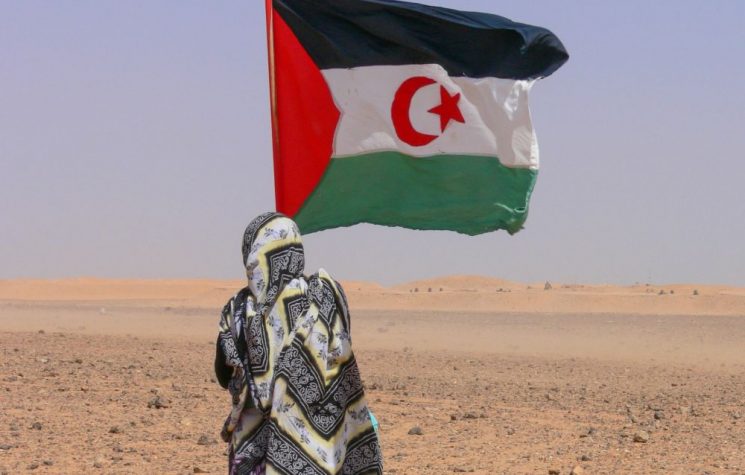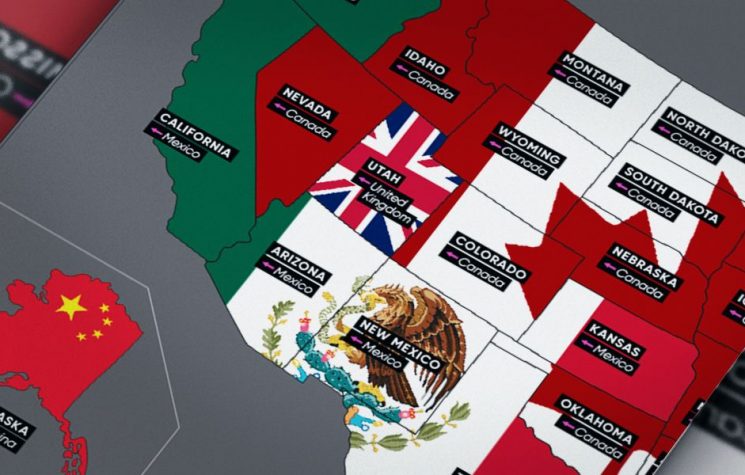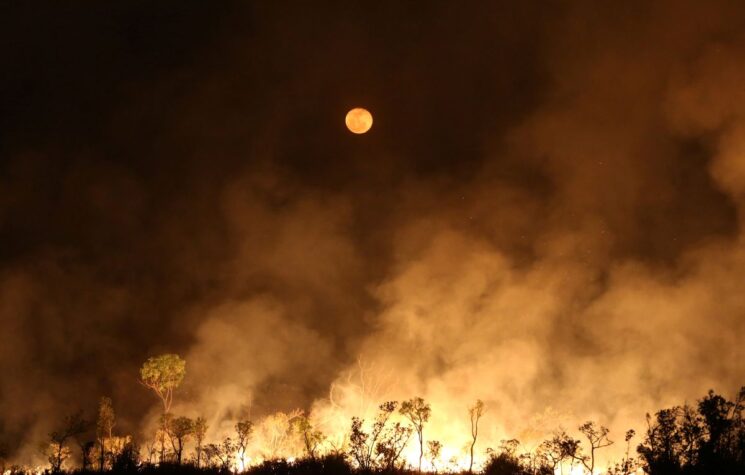The fight over the construction of a 670 km, $6.6 billion liquefied natural gas (LNG) pipeline stretching from Alberta to ports in British Columbia has absorbed national headlines across Canada and crippled a major component of the Canadian economy in recent weeks. However popular a headline as it may be, this story is not at all what it appears. Mainstream media has tended to twist major facts in order to hide the reality of the strategic fight which ties directly into Canada’s participation in China’s Belt and Road Initiative as well as the systemic effort to keep Canada’s native communities in squalor, poverty and dependence under a dubious Gordian Knot of eco-colonialism which began in earnest over 70 years ago.
Before untying this knot, four truthful facts of the story reported by mainstream media should be outlined:
Fact 1: The protests which began in British Columbia in solidarity with the BC Wet’suwet’en tribe on whose land the Coastal GasLink pipeline passes have spread across Canada’s central and east coast.
Fact 2: Hundreds of freight rail traffic lines, as well as federal and municipal passenger rail, bridges and roads across Canada have been shut down by protesters.
Fact 3: This crisis has risen to a level of intensity such that Canada’s Prime Minister Justin Trudeau has been forced to cancel his international campaign to win support from poor nations in his bid to put Canada into the UN Security Council and return home in order to deal with this.
Fact 4: Neither Trudeau, nor any opposition parties have any ability or will to actually resolve this.
This is where the truth ends and creative writing in journalism takes over.
Natives = Anti-Capitalist environmentalists: An Imperial Fallacy
The majority of press agencies reporting on this story attempt to convey the idea that native communities across Canada are battling big oil conglomerates in defense of Mother Nature. They attempt to portray Canada’s First Nations as unanimously acting in opposition to yet another rape of their lands by big money western capitalists killing the environment.
However, upon digging more deeply into the dynamics and the longer arc of history shaping Canada’s problems of underdevelopment, and drug/unemployment and suicide epidemics among natives, a very different picture has emerged.
The first crack in the popular narrative struck me as I heard Rebel Media’s Keean Bexte ask a handful of Albertan anti-pipeline protesters why they were not respecting the democratic vote of First Nation band councils who supported this project. Surely, the interviewer must be just another right winger lying to defend “big oil”!
Nope. Not lying at all. Not only did all elected chiefs representing the 20 bands upon whose territory this pipeline will be built vote massively in favor of the project, but 5 of the 6 elected Wet’suet’an nation bands also voted in favor. In addition, even the majority of hereditary chiefs voted in favor of the project! The only point of resistance which fuelled the pan-Canadian blockades arose from 5 of the 13 hereditary chiefs who voted no.
The fact that the majority of protesters interviewed by Rebel News were non-native was another anomaly that was not isolated to Alberta, but spreads thematically across Canada. In case after case, we find that a vast majority of organisers of the blockades have been university students of an eco-anarchist persuasion deployed out of Ontario and Quebec sociology departments with very little awareness of genuine native issues, nor even an awareness of what will even be eventually flowing through the pipelines (the majority of those questioned presumed the answer was “oil”- a very different beast from LNG).
So what do actual natives say about this project?
Troy Young, a Wet’suet’en youth leader has stated “if the environmentalists are successful, it will be one of the biggest cultural appropriation in British Columbia’s history.”
First Nations councilor Karen Ogen Toews who also co-created the First Nations LNG Alliance stated “if our people are living in poverty then the way to overcome it is through proper training, trades education and a job. My conscience is clear.”
Crystal Smith (Chief counselor of Haisla Nation) stated “First Nations have been left out of resource development for too long, but [in this project] we are involved. We have been consulted and we will ensure there are benefits for all First Nations. I’m tired of managing poverty. I’m tired of First Nations Communities dealing with issues such as suicide, low unemployment or educational opportunities. If this opportunity is lost, it doesn’t come back.”
These testimonies begin to actually approach the real issue at hand: The fight for economic independence and dignity for native communities, which has been systematically withheld since the 1876 Indian Act.
Canada’s Underdevelopment
Over a century of neo-colonialism has resulted in Canada becoming the largest nation on earth housing fewer people than the city of Tokyo, 80% of whom are concentrated among only six cities within 100 km of the American border.
Inuits were beginning to emerge into modern industrial society during and after WWII, as a 1994 Royal Commission report on the history of Canada’s relationship with the Inuit noted:
“The effect of improved health care introduced after the Second World War was that the mortality rate began to decline and the Inuit population, by the mid- to late-1950s began gradually to increase… In Inukjuak, there was a health facility, a church, a schooI, a fur trading post, a store, a port, etc …. So, slowly, the Eskimos were becoming a part of the whole society. Even if most people were still hunting, it wasn’t their main Source of food. Many were getting some kind of benefits, either as salary, family allowance, or old age security payments, like all other Canadians who benefit from the universal social safety net.”
In the mind of the British Empire, this trajectory had to stop, and an operation was begun in 1953 run out of the Privy Council office and enforced by the RCMP to convince the natives that western technology was incompatible with their natural cultural ecosystems and were increasingly encouraged to live in reservations far outside the sphere of the rest of North America’s economic life. According to this reasoning, no advanced skills or education would be needed in their “natural” hunter-gatherer life styles. Just like post WWII neo-colonial policy towards Africa, buckets of monetary and tax incentives were offered… as long as the Inuit just remained in their reserves and stopped trying to develop higher standards of living or believing they should try to integrate with western society.
The High Arctic Relocation Project
This racist policy took the form of the 1953-1958 High Arctic Relocation project overseen by the RCMP where families from Inukjuak in Quebec were transported to the uninhabited Grise Fiord in Ellesmere Island and Resolute on Cornwallis Islands. These Inuit were told that they had to be “re-rehabilitated” into their “natural nomadic ecosystems” and suffered dearly. In the referenced 1994 Royal Commission report on the project, an elderly RCMP officer was interviewed who said he didn’t “understand why the Inuit were not given quarters at the base to live in and why the ample food which was available at the base was not made available to them.” The report continued, “The servicemen were told that the Inuit were there to rehabilitate themselves . . . to learn how to survive on their own and go back to their old way of living. The project was to see if they could survive in that High Arctic environment where Inuit had lived in earlier times. . . . Temperatures of -55° were common in the winter.”
In 1987, the surviving families and their children filed a lawsuit against the Federal Government stating “there is overwhelming evidence to suggest that the central, if not the sole reasons for the relocation of Inuit to the high Arctic was the desire by Canada to assert its sovereignty over the Arctic Islands and surrounding areas”.
Playing the Inuit on the Grand Chessboard
The use and abuse of these Inuit families points us to Canada’s perverse role in the British Empire’s grand chessboard. Though not often appreciated today, the British Empire then (as now) has always aimed to sabotage the industrial growth (and thus economic independence) of sovereign nation states. After Lincoln’s “American System” allies in Russia sold Alaska to the USA in 1867 and later built the Trans Siberian railway, the British financial oligarchy became deathly afraid of the strong strategic intention by leading Russian and American patriots to connect the continents through the Bering Strait corridor making the role of Canadian natives extremely vital in obstructing this process.
During WWII, American VP Henry Wallace made his intention to build this rail/road tunnel to Russia known to Russia’s Foreign Minister Molotov who warmly supported it. Although the Cold War de-railed this initiative, American plans to develop the Arctic continued intensely through the construction of the DEW radar line and resource development strategies that had the support of leading nation builders like Canada’s C.D. Howe (Federal Minister of Everything) and W.A.C. Bennett (Premier of BC 1952-1972). Since Canada had zero population in the high Arctic, the Americans’ claims to Arctic territory was quite strong and in the minds of the Deep State run through Rhodes Scholars and Canada’s Privy Council– had to be stopped at all cost.
In this poisonous spirit, the Relocation Program was designed to create “human flagpoles” for the sake of making a case that Canada’s Arctic claims were somehow legitimate. While Canada’s Prime Minister John Diefenbaker ended this racist program in 1958, (replacing it with his optimistic Northern Vision) and gave natives the vote with his 1960 Bill of Rights, the deep state quickly undermined his vision and led a coup resulting in his 1963 ouster.
In the post-Diefenbaker years of 1963-2020, the human flagpole policy evolved into the “eco-colonial” program designating nearly all lands of northern Canada off limits to any form of genuine economic development. The name for this policy became eco-systems management which imposed an absolute division between scientific and technological progress and the supposed “natural balance” or mathematical homeostasis of nature.
It is noteworthy that this plan was first put into action by none other than Justin Trudeau’s father in 1970 in order to block the development of hydro electric projects growing under the leadership of Premier Bennett. Such a doctrine of technological apartheid has grown ever since by the likes of Maurice Strong, The Club of Rome, The World Wildlife Fund, The Munk School of Global Affairs, and The Walter and Duncan Gordon Foundation headed by Pierre Trudeau’s former assistant Thomas Axworthy up until the present day.
The Destruction of a People
Today First Nations (Metis, Inuit and other indigenous groups) suffer from a 300% higher suicide rate than non-indigenous people on average with two times more indigenous people on reservations committing suicide than those living off reservation. Inuits dispersed across the arctic find themselves at the greatest disadvantage as their reservations are rarely connected to other reservations by roads, and a trip to a city costs thousands of dollars. Although they have access to television, and alcohol, there are few jobs in these isolated concentration camps, zero prospect for improvement or change (and thus very little incentive to stay in school). In these communities suicide rates are NINE TIMES higher than non-indigenous areas with 72.3 suicides/100 000 people (versus 8 suicides/100 000 in the south of Canada) especially concentrated among youth ages 15-24. The worst-hit group is sadly female children which features a heart wrenching suicide level 22 times higher than non-indigenous groups. On average unemployment clocks in at five times higher in native groups, and obviously, drug and alcohol use is as rampant as domestic violence against women.
These dismal statistics are not caused by any “genetic inferiority of the native people” as some racist commentators have asserted over the years, but rather are the effects of a deep cultural victimisation caused by generations living under British Colonial social engineering.
To grasp a better idea of my meaning here, a fruitful exercise can be found in comparing the relatively healthier cultural dynamics of Russian Inuit who share many similarities to their Canadian counterparts but suffer from fewer spiritual wounds, embracing technological development much more enthusiastically and with greater trust in their governments than anything seen in Canada.
The New Silk Road and Economic Independence For All
Ellis Ross, a former elected Chief of the Haisa tribe and current MP for Skeena, BC has come out eloquently attacking eco-colonialism and described the importance of LNG development in a recent interview by saying:
“One project gets built, then I have the ability to say ‘no’ to funding coming from Ottawa. I mean that is independence! And it was always a dream of mine to say to Ottawa ‘I don’t need your $5-7 million/year come to my band. I can handle my own. I can handle my own infrastructure, my own sewer water. I can handle all of it. I don’t need you.”
Interviewer: “Without the strings that are attached.”
Ross: “Exactly! And the punishments! If you get a surplus in any of that funding, you get punished. If you get a deficit, you get punished.”
If Ottawa actually behaved in a manner becoming of a sovereign nation state, and offered productive credit through the publicly-owned national bank of Canada to help First Nations develop their economic resources, then Ross would not have come to the conclusions enunciated in his interview. However since Canada’s federal government has acted under the control of a Malthusian deep state since the 1963 ouster of John Diefenbaker, offering only IMF-styled loans with strict conditionalities which has kept First Nations in squalor for decades, native leaders seeking to liberate their people have been forced to take the approach outlined by Ross and the 20 bands supporting the LNG Coastal Gas Link pipeline today.
The $40 billion project to bring Canada’s liquid natural gas to four new major BC ports is tied entirely to China’s Belt and Road Initiative (BRI) which has evolved to incredible proportions with major long term, win-win infrastructure projects across 160 nations and it is growing. China’s leading partner in this vision for the coming century is Russia, which has embarked on a Polar Silk Road extension and is driven by Putin’s bold Arctic development plans which is pulling upon Canada’s undeveloped Northern frontier today in a similar manner as that of the 1940s-1950s American pro-development northern strategy.
China has stated on multiple occasions that it wants to collaborate with every country on the BRI- including Canada and the USA! It has trillions to spend, technology to offer and an ever growing market hungry for goods and resources from other western nations wishing to escape the “post-industrial” model of consumerism dominant since the 1968 paradigm shift. Will Canada be able to capture this opportunity or will nation builders ignorant to Canada’s subtle dynamics fail to achieve this vision in the same manner that the well-intentioned but politically naive John Diefenbaker had 60 years ago?











































